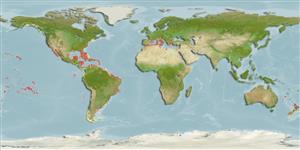Common names from other countries
Environment: milieu / climate zone / depth range / distribution range
Ecologie
Benthopelagisch; diepteverspreiding 0 - 20 m (Ref. 116114). Subtropical
Eastern Central Pacific, Western Central Atlantic and the Mediterranean.
Length at first maturity / Size / Gewicht / Leeftijd
Maturity: Lm ? range ? - ? cm Max length : 4.0 cm H mannelijk/geslacht niet bekend; (Ref. 2376)
Stings are painful; second most important stinging jellyfish on the southcoast of Italy; in the coast of Denia (Western Mediterranean Sea), summer of 2008, it showed an unusual high density and stung as many as 185 people d-1 (Ref. 116819). Neritic (Ref. 116114). Inhabits near shore, mangrove channels, and kelp forests (Ref. 1028). Polyps were once located attached to bivalve shells in a mangrove habitat in Puerto Rico, suggesting estuarine polyps (Ref. 116835). Medusae are associated with sandy beach with Posidonia oceanica meadows (Ref. 116819). Pathogenic (Ref. 116114). Mainly feeds on copepods, mysids and gammarids (Ref. 116521). Temperature is the main factor which affects its spatio-temporal abundance along the SW Mediterranean; other variables were low salinity and high coastal productivity (chl a and phosphate) (Ref. 116819).
Cairns, S.D., D.R. Calder, A. Brinckmann-Voss, C.B. Castro, D.G. Fautin, P.R. Pugh, C.E. Mills, W.C. Jaap, M.N. Arai, S.H.D. Haddock and D.M. Opresko. 2003. (Ref. 1663)
Status op de Rode Lijst van het IUCN (Ref. 130435)
Status bij CITES (Ref. 108899)
Not Evaluated
Not Evaluated
Gevaarlijk voor mensen
Harmless
Gebruik door de mens
| FishSource |
Tools
Meer informatie
Leeftijd/Grootte
Groei
Lengte-gewicht parameters
Lengte-lengte parameters
Morfologie
Larven
Abundantie
Internet-bronnen
Estimates based on models
Kwetsbaarheid
Low vulnerability (10 of 100).
Prijsklasse
Unknown.
